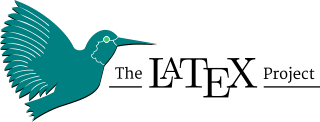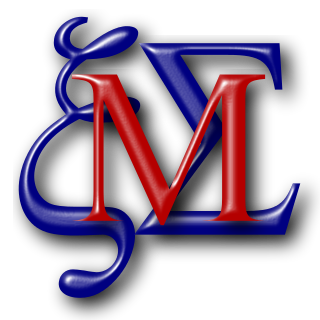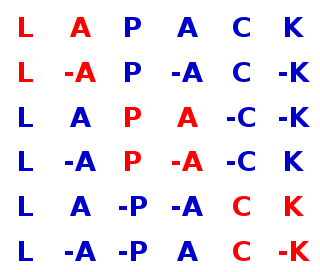Related Research Articles

LaTeX is a software system for typesetting documents. LaTeX markup describes the content and layout of the document, as opposed to the formatted text found in WYSIWYG word processors like Microsoft Word, LibreOffice Writer and Apple Pages. The writer uses markup tagging conventions to define the general structure of a document, to stylise text throughout a document, and to add citations and cross-references. A TeX distribution such as TeX Live or MiKTeX is used to produce an output file suitable for printing or digital distribution.

The TI-89 and the TI-89 Titanium are graphing calculators developed by Texas Instruments (TI). They are differentiated from most other TI graphing calculators by their computer algebra system, which allows symbolic manipulation of algebraic expressions—equations can be solved in terms of variables, whereas the TI-83/84 series can only give a numeric result.
A computer algebra system (CAS) or symbolic algebra system (SAS) is any mathematical software with the ability to manipulate mathematical expressions in a way similar to the traditional manual computations of mathematicians and scientists. The development of the computer algebra systems in the second half of the 20th century is part of the discipline of "computer algebra" or "symbolic computation", which has spurred work in algorithms over mathematical objects such as polynomials.

Maple is a symbolic and numeric computing environment as well as a multi-paradigm programming language. It covers several areas of technical computing, such as symbolic mathematics, numerical analysis, data processing, visualization, and others. A toolbox, MapleSim, adds functionality for multidomain physical modeling and code generation.

Maxima is a powerful software package for performing computer algebra calculations in mathematics and the physical sciences. It is written in Common Lisp and runs on all POSIX platforms such as macOS, Unix, BSD, and Linux, as well as under Microsoft Windows and Android. It is free software released under the terms of the GNU General Public License (GPL).

A graphing calculator is a handheld computer that is capable of plotting graphs, solving simultaneous equations, and performing other tasks with variables. Most popular graphing calculators are programmable calculators, allowing the user to create customized programs, typically for scientific, engineering or education applications. They have large screens that display several lines of text and calculations.

LAPACK is a standard software library for numerical linear algebra. It provides routines for solving systems of linear equations and linear least squares, eigenvalue problems, and singular value decomposition. It also includes routines to implement the associated matrix factorizations such as LU, QR, Cholesky and Schur decomposition. LAPACK was originally written in FORTRAN 77, but moved to Fortran 90 in version 3.2 (2008). The routines handle both real and complex matrices in both single and double precision. LAPACK relies on an underlying BLAS implementation to provide efficient and portable computational building blocks for its routines.
Basic Linear Algebra Subprograms (BLAS) is a specification that prescribes a set of low-level routines for performing common linear algebra operations such as vector addition, scalar multiplication, dot products, linear combinations, and matrix multiplication. They are the de facto standard low-level routines for linear algebra libraries; the routines have bindings for both C and Fortran. Although the BLAS specification is general, BLAS implementations are often optimized for speed on a particular machine, so using them can bring substantial performance benefits. BLAS implementations will take advantage of special floating point hardware such as vector registers or SIMD instructions.
Mathematical software is software used to model, analyze or calculate numeric, symbolic or geometric data.

Mathcad is computer software for the verification, validation, documentation and re-use of mathematical calculations in engineering and science, notably mechanical, chemical, electrical, and civil engineering. Released in 1986 on DOS, it introduced live editing (WYSIWYG) of typeset mathematical notation in an interactive notebook, combined with automatic computations. It was originally developed by Mathsoft, and since 2006 has been a product of Parametric Technology Corporation.

Mathomatic is a free, portable, general-purpose computer algebra system (CAS) that can symbolically solve, simplify, combine and compare algebraic equations, and can perform complex number, modular, and polynomial arithmetic, along with standard arithmetic. It does some symbolic calculus (derivative, extrema, Taylor series, and polynomial integration and Laplace transforms), numerical integration, and handles all elementary algebra except logarithms. Trigonometric functions can be entered and manipulated using complex exponentials, with the GNU m4 preprocessor. Not currently implemented are general functions like f(x), arbitrary-precision and interval arithmetic, and matrices.

SageMath is a computer algebra system (CAS) with features covering many aspects of mathematics, including algebra, combinatorics, graph theory, group theory, differentiable manifolds, numerical analysis, number theory, calculus and statistics.
Xcas is a user interface to Giac, which is an open source computer algebra system (CAS) for Windows, macOS and Linux among many other platforms. Xcas is written in C++. Giac can be used directly inside software written in C++.
FriCAS is a general purpose computer algebra system with a strong focus on mathematical research and development of new algorithms. It comprises an interpreter, a compiler and a still-growing library of more than 1,000 domains and categories.
Tensor software is a class of mathematical software designed for manipulation and calculation with tensors.
References
- 1 2 elijah (2014-08-26). "PPT - CPMP-Tools : PowerPoint Presentation, free download - ID:3575463". SlideServe. Retrieved 2020-01-17.
- ↑ "About "CPMP-Tools"". www.nctm.org. Archived from the original on 2020-01-15. Retrieved 2020-01-17.
- ↑ "Cpmp tools download". Archived from the original on 2020-01-15. Retrieved 2020-01-17.
- ↑ "CPMP-Tools Software". core-plusmath.org. Retrieved 2021-01-21.
- ↑ "Cpmp Tools Driver Download". semantic.gs. Retrieved 2020-01-17.
- ↑ "Edu Linux Plus // bovhoulasur.ml". bovhoulasur.ml. Retrieved 2020-01-17.[ permanent dead link ]
- ↑ "CPMP - Mathematical software - swMATH". swmath.org. Retrieved 2020-01-17.
- ↑ Burrill, Gail; Ben-Zvi, Dani (2019-02-15). Topics and Trends in Current Statistics Education Research: International Perspectives. Springer. ISBN 978-3-030-03472-6.
- ↑ Madden, Sandra. "Dynamic Technology Scaffolding". S2CID 14552896.
{{cite journal}}: Cite journal requires|journal=(help) - ↑ "Brian Lemmen CSMC Conference". csmc-intlconf.uchicago.edu. Retrieved 2020-01-17.
- ↑ Bates, Meg; Usiskin, Zalman (2016-02-01). Digital Curricula in School Mathematics. IAP. ISBN 978-1-68123-413-7.
- ↑ Elizabeth Krupa, Erin. "THE EFFECTS OF AN INTEGRATED MATHEMATICS PROFESSIONAL DEVELOPMENT PROJECT1" (PDF).